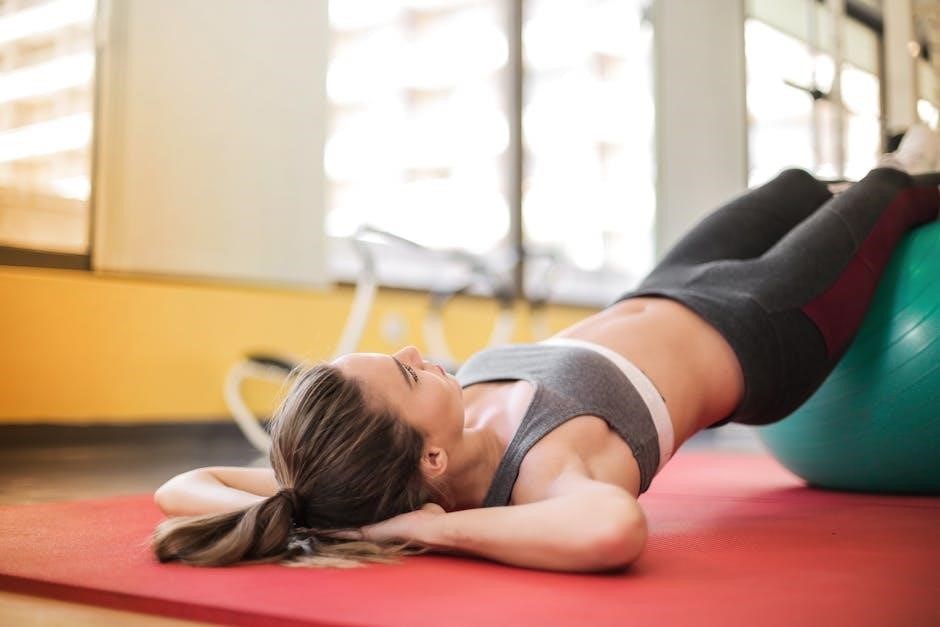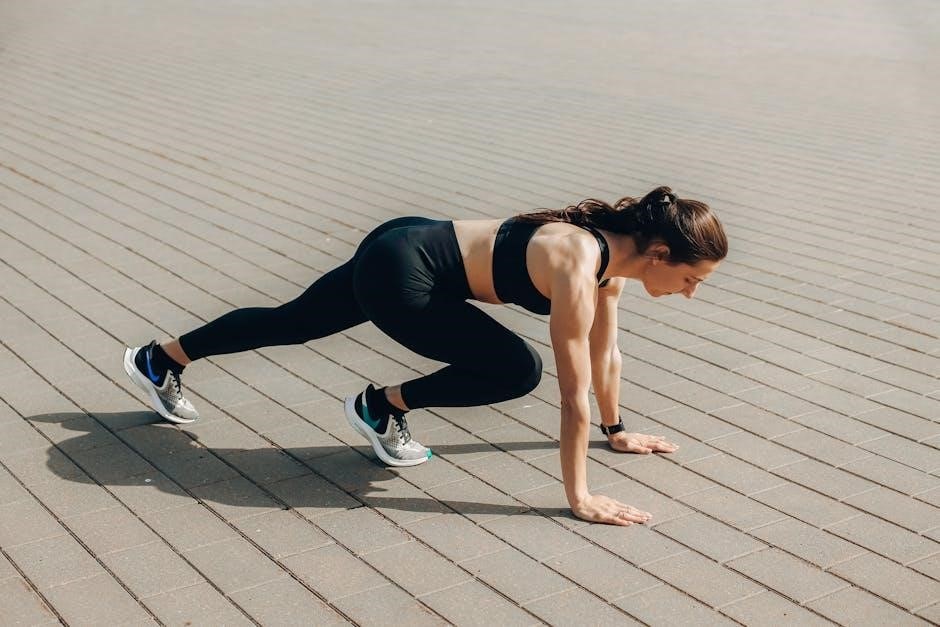Sacroiliac (SI) Joint Stabilization Exercises: A Comprehensive Guide
Welcome! This guide offers insights into managing sacroiliac (SI) joint pain through targeted exercises. Discover how to gently move your SI joint and prevent irritation. Remember, stop if you feel pain, and consult a professional if issues persist.
Understanding Sacroiliac (SI) Joint Pain
Sacroiliac (SI) joint pain is a common condition that affects many individuals, often manifesting as discomfort in the lower back, buttocks, and sometimes even radiating down the legs. The SI joint, located where the sacrum (the triangular bone at the base of the spine) meets the ilium (the largest bone in the pelvis), plays a crucial role in weight distribution and shock absorption during movement. Understanding the intricacies of this joint and the potential causes of pain is essential for effective management and relief.
SI joint pain can arise from a variety of factors, including but not limited to: traumatic injuries such as falls or car accidents, arthritis, pregnancy and childbirth due to hormonal changes and increased stress on the joint, leg length discrepancy leading to uneven weight distribution, and repetitive stress from activities like prolonged sitting or heavy lifting. The pain can vary in intensity, ranging from a dull ache to a sharp, stabbing sensation, and may be exacerbated by certain movements such as bending, twisting, or prolonged standing.
Furthermore, SI joint dysfunction can be difficult to diagnose accurately, as its symptoms often overlap with other conditions affecting the lower back and hip. A thorough physical examination, including specific orthopedic tests designed to assess SI joint mobility and stability, is typically necessary to confirm the diagnosis. Imaging studies, such as X-rays or MRI scans, may also be used to rule out other potential causes of pain, such as spinal stenosis or disc herniation.
It’s important to note that SI joint pain is not always indicative of a serious underlying problem. In many cases, it can be effectively managed with conservative treatments, including pain medication, physical therapy, and lifestyle modifications. However, if the pain is severe or persistent, further evaluation and treatment may be necessary to address the underlying cause and restore proper joint function. Understanding the nuances of SI joint pain is the first step towards finding effective solutions and regaining a pain-free, active lifestyle.
Importance of SI Joint Stabilization Exercises
Sacroiliac (SI) joint stabilization exercises are paramount in managing and alleviating pain associated with SI joint dysfunction. These exercises focus on strengthening the muscles surrounding the SI joint, promoting stability, and restoring proper biomechanics. A stable SI joint is crucial for efficient weight transfer between the upper and lower body, shock absorption during movement, and overall spinal health. When the muscles supporting the SI joint are weak or imbalanced, the joint can become unstable, leading to pain, inflammation, and restricted movement.
The primary goal of SI joint stabilization exercises is to enhance the strength and endurance of the core muscles, including the abdominal muscles, back muscles, and pelvic floor muscles. These muscles work together to provide a supportive framework for the spine and pelvis, reducing stress on the SI joint. By strengthening these muscles, individuals can improve their posture, reduce the risk of injury, and alleviate pain associated with SI joint dysfunction.
Moreover, SI joint stabilization exercises can help to restore proper alignment and movement patterns in the pelvis and spine. When the SI joint is misaligned, it can lead to compensatory movements in other parts of the body, resulting in muscle imbalances and pain. By performing targeted exercises that focus on restoring proper joint mechanics, individuals can improve their overall movement efficiency and reduce the risk of further injury.
In addition to strengthening the core muscles, SI joint stabilization exercises also emphasize improving flexibility and range of motion in the hips and lower back. Tightness in these areas can contribute to SI joint dysfunction by restricting movement and increasing stress on the joint. Stretching exercises can help to release tension in the surrounding muscles and improve joint mobility, promoting pain relief and restoring normal function.
Regularly performing SI joint stabilization exercises can provide numerous benefits, including reduced pain, improved stability, enhanced mobility, and increased overall function. These exercises are an essential component of a comprehensive treatment plan for SI joint dysfunction and can help individuals regain a pain-free, active lifestyle. Consulting with a physical therapist or other qualified healthcare professional is recommended to develop a personalized exercise program that meets individual needs and goals.
Common SI Joint Stabilization Exercises
Several exercises can effectively stabilize the Sacroiliac (SI) joint and alleviate associated pain. These exercises generally focus on strengthening the core, pelvic, and hip muscles, promoting proper alignment and reducing stress on the SI joint. Here are some common and effective SI joint stabilization exercises:
- Pelvic Tilts: This gentle exercise helps improve pelvic mobility and strengthen abdominal muscles. Lie on your back with knees bent and feet flat on the floor. Gently tilt your pelvis forward, creating a small arch in your lower back, and then tilt it backward, flattening your lower back against the floor. Repeat this movement rhythmically, focusing on controlled and smooth motions.
- Knee to Chest Stretch: This stretch targets the hip flexors and lower back muscles, improving flexibility and reducing tension around the SI joint. Lie on your back with knees bent. Gently pull one knee towards your chest, holding the position for a few seconds. Repeat with the other leg. You can also pull both knees to your chest simultaneously.
- Bridging Exercise: Bridging strengthens the glutes, hamstrings, and core muscles, providing stability to the pelvis and SI joint. Lie on your back with knees bent and feet flat on the floor. Engage your core and lift your hips off the floor, creating a straight line from your shoulders to your knees. Hold this position for a few seconds and then slowly lower your hips back down.
- Bird Dog Exercise: This exercise improves core stability and coordination while challenging balance. Start on your hands and knees. Extend one arm forward and the opposite leg backward simultaneously, maintaining a straight line from your head to your heel. Hold this position briefly and then return to the starting position. Repeat with the other arm and leg.

- Side Plank: Side planks strengthen the obliques and other core muscles, providing lateral stability to the spine and pelvis. Lie on your side with your elbow directly beneath your shoulder and your legs stacked on top of each other. Engage your core and lift your hips off the floor, creating a straight line from your head to your feet. Hold this position for as long as you can maintain good form.
- Clamshell Exercise: This exercise targets the gluteus medius, a key muscle for hip stability and SI joint function. Lie on your side with your knees bent and your feet stacked on top of each other. Keeping your feet together, slowly raise your top knee away from your bottom knee, maintaining a neutral spine.
Remember to perform these exercises with proper form and within a pain-free range of motion. If you experience any discomfort or pain, stop the exercise and consult with a physical therapist or other healthcare professional.
Pelvic Tilts
Pelvic tilts are a gentle and effective exercise for improving pelvic mobility, strengthening core muscles, and relieving pain associated with Sacroiliac (SI) joint dysfunction. This exercise helps to restore proper pelvic alignment and reduce stress on the SI joint by engaging the abdominal and lower back muscles. Here’s a detailed guide on how to perform pelvic tilts correctly:
Starting Position:
- Lie on your back on a comfortable surface, such as a yoga mat or a firm bed.
- Bend your knees, keeping your feet flat on the floor, hip-width apart.
- Relax your shoulders and neck.
Execution:
Posterior Pelvic Tilt (Flattening the Back):

- Engage your abdominal muscles.
- Gently tilt your pelvis backward, drawing your pubic bone towards your nose.
- This action will flatten your lower back against the floor, eliminating the natural arch.
- Hold this position for a few seconds, feeling the contraction in your abdominal muscles.
Anterior Pelvic Tilt (Arching the Back):
- Gently tilt your pelvis forward, allowing your lower back to arch slightly off the floor.
- Your pubic bone will move away from your nose.
- Avoid excessive arching, as this can strain your lower back.
- Hold this position for a few seconds, feeling a gentle stretch in your lower back.
Rhythmic Movement:
- Alternate between the posterior and anterior pelvic tilts in a slow, controlled, and rhythmic manner.
- Focus on smooth transitions between the two positions.
- Breathe deeply and evenly throughout the exercise.
Repetitions and Sets:
- Start with 10-15 repetitions.
- Perform 2-3 sets of pelvic tilts.
- You can gradually increase the number of repetitions and sets as your strength and comfort level improve.
Important Considerations:
Pain-Free Range of Motion: Perform the exercise within a pain-free range of motion. If you experience any pain or discomfort, stop immediately.
Proper Form: Maintain proper form throughout the exercise to avoid injury.
Controlled Movement: Avoid jerky or sudden movements.
Breathing: Breathe deeply and evenly throughout the exercise.
Progression: As you get stronger, you can progress the exercise by holding each tilt for a longer period or by adding resistance (e.g., using a resistance band around your knees).
Pelvic tilts can be incorporated into your daily routine to improve pelvic stability, reduce SI joint pain, and enhance overall core strength. Regular practice of this exercise can contribute to better posture, reduced lower back pain, and improved functional movement.
Knee to Chest Stretch
The Knee to Chest Stretch is a simple yet effective exercise for relieving lower back pain and improving flexibility in the hips and hamstrings, which can indirectly benefit the Sacroiliac (SI) joint. This stretch helps to gently lengthen the muscles surrounding the SI joint, reducing tension and promoting better joint mobility. Here’s a detailed guide on how to perform the Knee to Chest Stretch correctly:
Starting Position:
- Lie on your back on a comfortable surface, such as a yoga mat or a soft carpet.
- Keep your legs extended straight out, with your feet relaxed.
- Your arms should be resting comfortably at your sides.
- Make sure your head and neck are relaxed.
Execution:
Single Knee to Chest:
- Bend one knee and bring it towards your chest.
- Use your hands to gently pull your knee closer to your chest, deepening the stretch.
- Avoid pulling too hard; the stretch should be gentle and comfortable.
- Keep your other leg extended straight on the floor.
- Hold this position for 20-30 seconds, breathing deeply and evenly.
- Slowly release your knee and return your leg to the starting position.
Alternating Knees:
- Repeat the exercise with your other leg, bringing that knee to your chest.
- Alternate between each leg, performing the stretch on each side.
- Focus on maintaining a relaxed posture and breathing deeply.
- Continue alternating for 10-15 repetitions on each leg.
Double Knee to Chest (Advanced):
- Bend both knees and bring them towards your chest simultaneously.
- Use your hands to gently pull both knees closer to your chest, deepening the stretch.
- Make sure to keep your lower back pressed against the floor.
- Hold this position for 20-30 seconds, breathing deeply and evenly.
- Slowly release your knees and return your legs to the starting position.
- Repeat this stretch for 10-15 repetitions.
Important Considerations:
Pain-Free Range of Motion: Perform the exercise within a pain-free range of motion. If you experience any pain or discomfort, stop immediately.
Proper Form: Maintain proper form throughout the exercise to avoid injury.
Controlled Movement: Avoid jerky or sudden movements.
Breathing: Breathe deeply and evenly throughout the exercise. Exhale as you bring your knee(s) to your chest and inhale as you release.
Progression: As you get stronger, you can hold the stretch for a longer period or gently rock from side to side to massage your lower back.
The Knee to Chest Stretch can be incorporated into your daily routine to improve lower back flexibility, reduce SI joint tension, and enhance overall comfort. Regular practice of this exercise can contribute to better posture, reduced muscle stiffness, and improved functional movement.
Bridging Exercise
The Bridging exercise is a highly effective movement for strengthening the glutes, hamstrings, and core muscles, all of which play a crucial role in stabilizing the Sacroiliac (SI) joint. By engaging these muscle groups, the Bridging exercise helps to improve pelvic stability, reduce stress on the SI joint, and alleviate lower back pain. Here’s a comprehensive guide on how to perform the Bridging exercise correctly:
Starting Position:

- Lie on your back on a comfortable surface, such as a yoga mat or a soft carpet.
- Bend your knees, keeping your feet flat on the floor, hip-width apart.
- Your arms should be resting comfortably at your sides, palms facing down.
- Ensure your head and neck are relaxed, looking straight up at the ceiling.
Execution:
Engage Core and Glutes:
- Before lifting your hips, gently engage your core muscles by drawing your belly button towards your spine.
- Squeeze your glute muscles to prepare for the lift.
Lift Hips Off the Floor:
- Press through your heels to lift your hips off the floor, creating a straight line from your knees to your shoulders.
- Avoid arching your back excessively; focus on maintaining a neutral spine.
- Ensure your glutes and hamstrings are doing the work, not your lower back.
Hold the Bridge Position:
- Hold the bridge position for 2-3 seconds, continuing to squeeze your glutes and engage your core.
- Breathe deeply and evenly throughout the hold, maintaining proper form.
Lower Hips Back Down:

- Slowly lower your hips back down to the floor, one vertebra at a time, until your entire back is resting on the surface.
- Control the movement to prevent any sudden drops or jarring motions.
Repeat the Exercise:
- Repeat the bridging exercise for 10-15 repetitions, maintaining proper form and control throughout each repetition.
- Rest briefly between sets if needed, and perform 2-3 sets in total.
Important Considerations:
Pain-Free Range of Motion: Perform the exercise within a pain-free range of motion. If you experience any pain or discomfort, stop immediately.
Proper Form: Maintain proper form throughout the exercise to avoid injury.
Controlled Movement: Avoid jerky or sudden movements.
Breathing: Breathe deeply and evenly throughout the exercise. Exhale as you lift your hips and inhale as you lower them.
Progression: As you get stronger, you can increase the duration of the hold or add resistance by placing a weight plate on your hips.
The Bridging exercise can be incorporated into your daily routine to improve lower back and pelvic stability, reduce SI joint pain, and enhance overall functional strength. Regular practice of this exercise can contribute to better posture, reduced muscle stiffness, and improved athletic performance.
Benefits of Regular Exercise for SI Joint Health
Progression and Precautions
Embarking on a journey of SI joint stabilization requires a mindful approach, emphasizing gradual progression and diligent precautions to ensure safety and effectiveness. As you incorporate exercises into your routine, understanding how to advance appropriately and recognizing potential risks is paramount.
Progression: A Gradual Ascent
The key to successful SI joint stabilization lies in a progressive approach. Begin with foundational exercises, focusing on mastering proper form and technique. As your strength and stability improve, gradually increase the intensity and complexity of your workouts.
- Increase Repetitions and Sets: Start with a manageable number of repetitions and sets, gradually increasing as you gain strength and endurance. For example, begin with 10 repetitions of each exercise for 2 sets, and progressively increase to 15 repetitions for 3 sets.
- Add Resistance: Once you can comfortably perform exercises with body weight, consider adding resistance using resistance bands, light weights, or exercise balls. This will challenge your muscles further and promote greater stabilization.
- Advance Exercise Complexity: As you become more proficient, progress to more challenging exercises that require greater balance, coordination, and core engagement. Examples include single-leg stances, dynamic stretches, and functional movements.
Precautions: Safeguarding Your Well-being
While exercise is beneficial, it’s crucial to prioritize safety and listen to your body’s signals. Taking necessary precautions can help prevent injuries and ensure a positive rehabilitation experience.
- Consult a Healthcare Professional: Before starting any exercise program, especially if you have pre-existing conditions or experience pain, consult a physical therapist, chiropractor, or physician. They can assess your specific needs and provide tailored recommendations.
- Proper Form: Maintain proper form and technique throughout each exercise to prevent strain and injury. If you’re unsure about the correct form, seek guidance from a qualified professional.
- Pain Management: Pay close attention to your body’s signals and avoid pushing through pain. If you experience any sharp or persistent pain, stop the exercise and consult a healthcare provider.
- Warm-up and Cool-down: Always begin your workouts with a gentle warm-up to prepare your muscles for exercise. Similarly, end with a cool-down to promote relaxation and prevent muscle soreness.
- Listen to Your Body: Be mindful of your body’s limitations and adjust your exercise routine accordingly. Rest when needed and avoid overexertion.
By adhering to a progressive approach and taking necessary precautions, you can safely and effectively embark on your journey towards SI joint stabilization, improving your overall well-being and quality of life.
